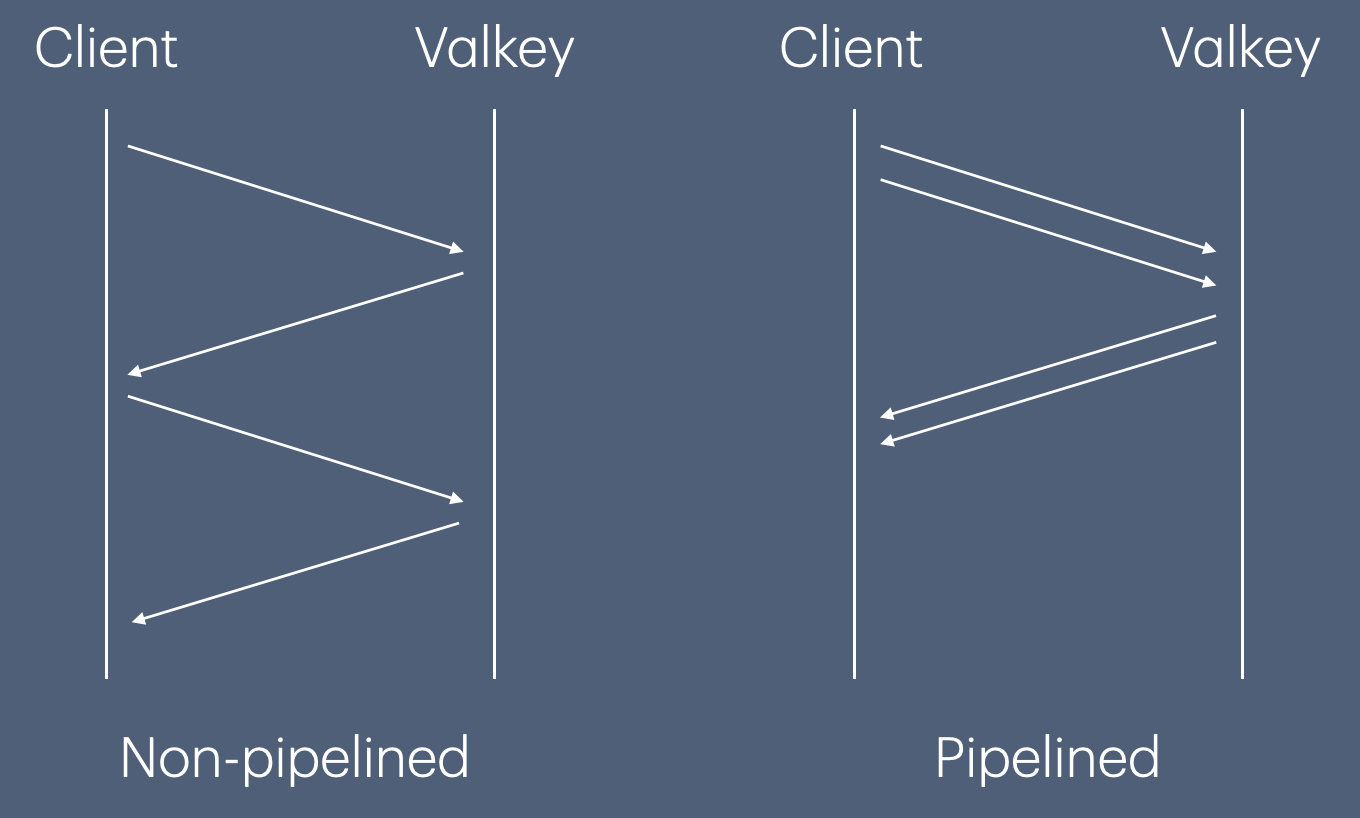
Introducing valkey-swift, the Swift client for Valkey
We are excited to introduce the preview release of valkey-swift, a new Swift based client library for Valkey.
The Client
Valkey-swift is a modern swift client built with Swift concurrency in mind. Using Valkey from Swift lets you take advantage of a strongly typed API, Swift's memory and data race safety guarantees, as well as maintaining a very light memory footprint. The API uses structured concurrency; a paradigm designed to bring clarity to concurrent programming by using the structure of your code to define the lifetimes of tasks and associated resources. This allows you to reason about your code locally. The client includes the following features:
Connection Pool
The client includes a persistent connection pool. Instead of establishing a new connection for every request, it leases a connection from a pool of existing connections. This minimizes the time and resources required to get a connection to your Valkey server.
Commands
The project uses code generation to generate all of Valkey's command set. This ensures that all of Valkey's features are available, and includes the string, list, set, sorted set, stream, hash, geospatial, hyperloglog, and pub/sub commands. Using code generation has the added bonus of allowing us to easily keep up to date with the latest Valkey command changes. All the Valkey commands are available directly from ValkeyClient.
try await valkeyClient.set("Key1", value: "Test")
let value = try await valkeyClient.get("Key1")
Each call to a command using ValkeyClient leases a connection from the connection pool to run that single command, so we provide an alternative where you can lease a single connection to run multiple commands as follows:
try await valkeyClient.withConnection { connection in
try await connection.set("Key1", value: "Test")
let value = try await connection.get("Key1")
}
When exiting the closure the connection is auto-released, avoiding the potential user error of forgetting to return the connection to the connection pool.
Pipelining
Valkey Pipelining is a technique for improving performance. It sends multiple commands at the same time without waiting for the response of each individual command. It avoids the round trip time between each command, and removes the relation between receiving the response from a request and sending the next request.

Valkey-swift provides support for pipelining in a couple of different ways.
First, you can do this using the execute(_:) function available from both ValkeyClient and ValkeyConnection.
This sends all the commands off at the same time and receives a tuple of responses.
Swift allows this client to present a strongly typed API, ensuring it both accepts the correct types for multiple commands and returns the correct types for responses.
let (lpushResult, rpopResult) = await valkeyClient.execute(
LPUSH("Key2", elements: ["entry1", "entry2"]),
RPOP("Key2")
)
let count = try lpushResult.get() // 2
let value = try rpopResult.get() // ByteBuffer containing "entry1" string
The second way to take advantage of pipelining is to use Swift Concurrency. Because the ValkeyConnection type is a Swift actor it can be used across concurrent tasks without concern for data race issues.
Unlike the execute(_:) function the commands will be sent individually but the sending of a command is not dependent on a previous command returning a response.
try await valkeyClient.withConnection { connection in
try await withThrowingTaskGroup(of: Void.self) { group in
// run LPUSH and RPUSH concurrently
group.addTask {
try await connection.lpush(key: "foo1", element: ["bar"])
}
group.addTask {
try await connection.rpush(key: "foo2", element: ["baz"])
}
}
}
Pub/Sub
Valkey can be used as a message broker using its publish/subscribe messaging model. A subscription is a stream of messages from a channel. The easiest way to model this is with a Swift AsyncSequence. The valkey-swift subscription API provides a simple way to manage subscriptions with a single function call that automatically subscribes and unsubscribes from channels as needed. You provide it with a closure, it calls SUBSCRIBE on the channels you specified, and provides an AsyncSequence of messages from those channels. When you exit the closure, the connection sends the relevant UNSUBSCRIBE commands. This avoids the common user error of forgetting to unsubscribe from a channel once it is no longer needed.
try await valkeyClient.withConnection { connection in
try await connection.subscribe(channels: ["channel1"]) { subscription in
for try await message in subscription {
print(String(buffer: message.message))
}
}
}
Valkey Cluster
Valkey scales horizontally with a deployment called Valkey Cluster. Data is sharded across multiple Valkey servers based on the hash of the key being accessed. It also provides a level of availability, using replicas. You can continue operations even when a node fails or is unable to communicate.
Swift-valkey includes a cluster client ValkeyClusterClient. This includes support for:
- Election based cluster topology discovery and maintenance.
- Command routing to the appropriate node based on key hashslots.
- Handling of MOVED errors for proper cluster resharding.
- Connection pooling and failover.
- Circuit breaking during cluster disruptions.
The following example shows how to create a cluster client that uses ValkeyStaticNodeDiscovery to find the first node in the cluster. From there the client discovers the remains of the cluster topology.
let clusterClient = ValkeyClusterClient(
clientConfiguration: clientConfiguration,
nodeDiscovery: ValkeyStaticNodeDiscovery([
.init(host: "127.0.0.1", port: 9000, useTLS: true)
]),
logger: logger
)
All the standard Valkey commands are available to the cluster client. The only requirement is that if a command references two of more keys, they all come from the same shard in the cluster.
try await clusterClient.xread(
milliseconds: 10000,
streams: .init(key: ["events"], id: ["0-0"])
)
Try it out
If you don't already have Swift installed you can find install instructions on the swift.org site.
Start a new project...
$ mkdir try-valkey-swift
$ cd try-valkey-swift
$ swift package init --type executable
Creating executable package: try-valkey-swift
Creating Package.swift
Creating .gitignore
Creating Sources/
Creating Sources/main.swift
Add the valkey-swift package to the project and executable target
$ swift package add-dependency https://github.com/valkey-io/valkey-swift --branch main
Updating package manifest at Package.swift... done.
$ swift package add-target-dependency Valkey try-valkey-swift --package valkey-swift
Updating package manifest at Package.swift... done.
If you are running on macOS, edit the generated Package.swift to add a minimum required platform
let package = Package(
name: "try-valkey-swift",
platforms: [.macOS(.v15)],
...
Open up Sources/main.swift and replace its contents with
import Logging
import Valkey
let logger = Logger(label: "Valkey")
let valkeyClient = ValkeyClient(.hostname("127.0.0.1", port: 6379), logger: logger)
try await withThrowingTaskGroup { group in
group.addTask {
// run connection manager background process
await valkeyClient.run()
}
try await testValkey(valkeyClient, logger: logger)
group.cancelAll()
}
/// Lets test valkey-swift.
func testValkey(_ valkeyClient: ValkeyClient, logger: Logger) async throws {
try await valkeyClient.set("foo", value: "bar")
let foo = try await valkeyClient.get("foo")
if let foo {
logger.info("foo = \(String(buffer: foo))")
} else {
logger.info("foo is empty")
}
}
The code above creates a client. The client needs a background process to manage its connection pool so it sets up a TaskGroup which runs the connection pool background process concurrently with the testValkey function. The code in the testValkey function sets the value of key "foo" to "bar" and then gets the value of key "foo". If it returns a value it is printed to the log.
To run your code use on the command line:
swift run
Get Involved
We'd love you to try the client out and get your feedback.
- How does the public API work for you?
- We know some features are not yet available, for example reading from replicas and Sentinel, but what other features do you think are needed?
- Performance has been a major focus during development, but how is the client working out in your production environment?
Connect with us
If you want to discuss any of the above, want to report a bug or want to contribute please reach out to us on GitHub or talk to us in the #valkey-swift channel on the Valkey Slack.
